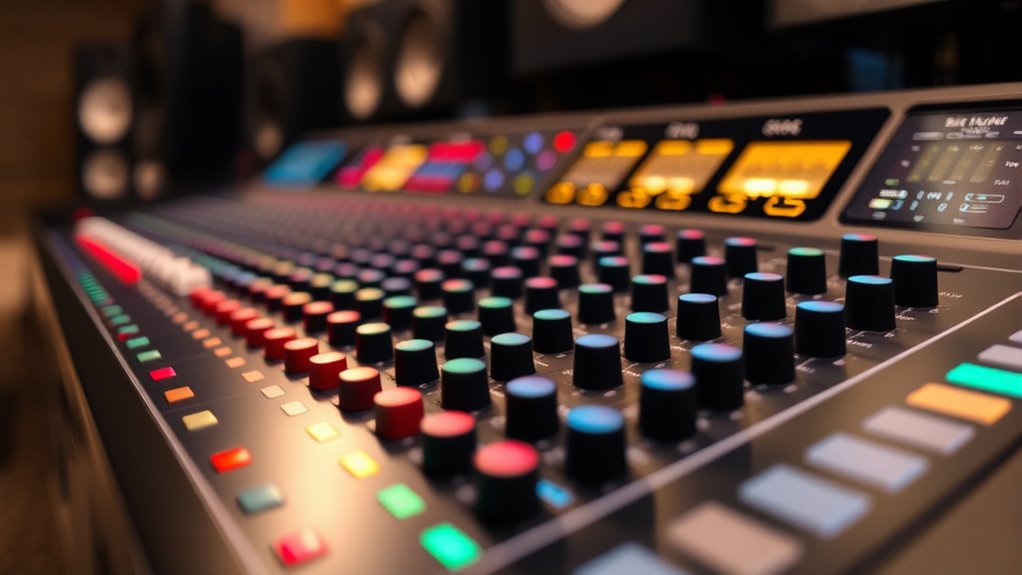To glue a mix with bus compression, start by choosing a compressor with a gentle ratio and moderate attack and release settings. Blend the heavily compressed signal with the original to preserve punch and dynamics, creating a cohesive sound. Use sidechain effects to carve out space for key elements and prevent muddiness. Fine-tuning these settings helps you achieve clarity and warmth, making your mix sound polished—keep exploring to master this powerful technique.
Key Takeaways
- Use a bus compressor with moderate ratios and slow attack to gently glue mix elements without squashing dynamics.
- Blend the compressed bus signal subtly with the dry mix to add cohesion while maintaining clarity.
- Apply parallel compression by blending heavily compressed signals at lower levels for a thicker, glued sound.
- Utilize sidechain effects to carve space and prevent muddiness, enhancing overall tonal balance.
- Fine-tune attack and release settings to preserve transients and avoid artifacts, ensuring a natural, cohesive mix.

Using bus compression is an effective way to glue your mix together, creating a cohesive and polished sound. When applied correctly, it helps blend individual elements into a unified whole, preventing any particular instrument or vocal from sticking out too much. One powerful technique to enhance this effect is parallel processing, where you blend a heavily compressed version of your mix or track with the original. This approach allows you to retain the dynamics and transients of the original while adding the weight and glue from the compressed signal. It’s especially useful on the drum bus, bass, or vocals, where you want to maintain clarity but also achieve a sense of cohesion. Additionally, Kia Tuning techniques can be employed to optimize the overall tonal balance, ensuring that the glue created by bus compression enhances the mix without introducing unwanted artifacts.
Parallel processing combined with bus compression provides more control over your mix’s overall density. Instead of heavily compressing the entire bus, you duplicate the signal and process one copy with a bus compressor, then mix it back in at a lower level. This technique preserves the punch and articulation of your instruments while giving the mix a thicker, more glued-together feel. It’s a subtle but highly effective way to add depth without sacrificing dynamics. Experiment with different ratios, attack, and release settings to find the balance that works best for your track.
Sidechain effects are another key element you can incorporate when using bus compression. By setting up sidechain inputs, you can make certain elements duck or soften in response to others. For example, applying sidechain compression on the bus with the kick drum as the trigger makes the mix breathe more naturally, preventing muddiness and creating space for the kick to cut through. This technique can also be used creatively to add rhythmic movement, emphasizing particular instruments or vocals during specific sections. When combined with bus compression, sidechain effects help you sculpt the mix, ensuring each element sits perfectly in the context of the whole.
Frequently Asked Questions
Can Bus Compression Improve Mix Clarity Without Sacrificing Dynamics?
Yes, bus compression can improve mix clarity without sacrificing dynamics if you use parallel processing and sidechain techniques. By blending the compressed bus with the dry mix, you retain the natural feel while adding cohesion. Sidechain compression helps control specific elements, preventing over-compression. This approach enhances clarity, maintains punch, and preserves dynamic range, giving your mix a polished and balanced sound without losing essential movement.
What Are Common Mistakes When Applying Bus Compression?
Applying bus compression is like walking a tightrope—you need balance. A common mistake is overusing parallel processing, which can make your mix muddy. Also, setting attack timing too fast can squash transients, dulling energy. Instead, dial in carefully, blending compressed and uncompressed signals, and adjust attack timing to retain punch. Avoid these errors, and you’ll enhance clarity without losing dynamics, achieving a polished, cohesive sound.
How Do I Choose the Right Ratio for Bus Compression?
When choosing the right ratio for bus compression, focus on your desired dynamic control. Start with a moderate ratio, like 4:1, to gently smooth out the mix without squashing the dynamics. If you want more noticeable control, increase the ratio gradually. Avoid extreme ratios unless you’re aiming for a heavily compressed sound. Adjust based on how transparent or aggressive you want the compression to sound, always listening carefully to the results.
Does Bus Compression Work Differently on Various Music Genres?
Yes, bus compression works differently across genres because genre-specific techniques shape its impact. You’ll notice it tightens the mix more in genres like pop or EDM, where dynamic profiles are balanced for punch and clarity. In contrast, genres like jazz or classical often require subtler compression to preserve natural dynamics. By understanding these genre-specific nuances, you can tailor your bus compression to enhance each style’s unique vibe.
Can Bus Compression Replace Individual Track Compression?
Bus compression can’t fully replace individual track compression because it works best for glue and cohesion, not detailed control. You can use parallel processing to retain clarity, and bus compression helps enhance stereo imaging and balance. However, for precise control over dynamics and tone on specific instruments, you still need track compression. Combining both approaches yields a more polished, balanced mix without sacrificing detail or spatial effects.
Conclusion
By applying bus compression, you unify your mix, giving it that professional sheen, much like a master chef blending flavors seamlessly. Remember, it’s not about overdoing it—think of it as the final brushstroke on a masterpiece. With patience and subtlety, you’ll find your mix sits together perfectly, like a vinyl record spinning smoothly in the age of streaming. Trust the process, and let the glue of bus compression bring your tracks into harmonious focus.









